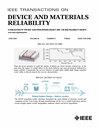Cause Analysis on the Abnormal Failure of SiC Power Modules During the HV-H3TRB Tests
IF 2.5
3区 工程技术
Q2 ENGINEERING, ELECTRICAL & ELECTRONIC
IEEE Transactions on Device and Materials Reliability
Pub Date : 2024-03-20
DOI:10.1109/TDMR.2024.3379498
引用次数: 0
Abstract
The SiC die has broad application prospects in new energy vehicles due to its excellent performances. In recent years, with the continuous development, the safety and reliability of SiC power modules have become particularly important and highly valued. In this paper, a case about the abnormal failure of SiC power modules during the High Voltage-High Humidity High Temperature Reverse Bias (HV-H3TRB) tests was addressed. According to the failure phenomena, a systematical investigation was conducted to explore the root cause by a series of methods such as failure point localization, synchrotron radiation infrared spectrum (SR-IR), time of flight-secondary ion mass spectrometry (TOF-SIMS), the ion beam method, scanning electron microscope (SEM) equipped with the energy dispersive spectrometer (EDS). Finally, the root cause of the failure was determined through comprehensive analysis, and based on the conclusions, some corresponding countermeasures were also proposed. Hopefully, the achievements obtained in this paper would be of great significance for improving the reliability of SiC power modules and avoiding similar failure in future manufacturing process.HV-H3TRB 测试期间 SiC 功率模块异常故障原因分析
SiC 芯片因其优异的性能,在新能源汽车领域有着广阔的应用前景。近年来,随着SiC电源模块的不断发展,其安全性和可靠性变得尤为重要和备受重视。本文针对 SiC 功率模块在高电压-高湿度-高温反向偏置(HV-H3TRB)试验中出现的异常失效案例进行了分析。根据故障现象,通过故障点定位、同步辐射红外光谱(SR-IR)、飞行时间-二次离子质谱(TOF-SIMS)、离子束法、配备能量色散光谱仪(EDS)的扫描电子显微镜(SEM)等一系列方法进行了系统调查,以探究故障的根本原因。最后,通过综合分析确定了失效的根本原因,并在此基础上提出了一些相应的对策。希望本文所取得的成果对提高碳化硅功率模块的可靠性,避免在今后的制造过程中出现类似故障具有重要意义。
本文章由计算机程序翻译,如有差异,请以英文原文为准。
求助全文
约1分钟内获得全文
求助全文
来源期刊

IEEE Transactions on Device and Materials Reliability
工程技术-工程:电子与电气
CiteScore
4.80
自引率
5.00%
发文量
71
审稿时长
6-12 weeks
期刊介绍:
The scope of the publication includes, but is not limited to Reliability of: Devices, Materials, Processes, Interfaces, Integrated Microsystems (including MEMS & Sensors), Transistors, Technology (CMOS, BiCMOS, etc.), Integrated Circuits (IC, SSI, MSI, LSI, ULSI, ELSI, etc.), Thin Film Transistor Applications. The measurement and understanding of the reliability of such entities at each phase, from the concept stage through research and development and into manufacturing scale-up, provides the overall database on the reliability of the devices, materials, processes, package and other necessities for the successful introduction of a product to market. This reliability database is the foundation for a quality product, which meets customer expectation. A product so developed has high reliability. High quality will be achieved because product weaknesses will have been found (root cause analysis) and designed out of the final product. This process of ever increasing reliability and quality will result in a superior product. In the end, reliability and quality are not one thing; but in a sense everything, which can be or has to be done to guarantee that the product successfully performs in the field under customer conditions. Our goal is to capture these advances. An additional objective is to focus cross fertilized communication in the state of the art of reliability of electronic materials and devices and provide fundamental understanding of basic phenomena that affect reliability. In addition, the publication is a forum for interdisciplinary studies on reliability. An overall goal is to provide leading edge/state of the art information, which is critically relevant to the creation of reliable products.
 求助内容:
求助内容: 应助结果提醒方式:
应助结果提醒方式:


